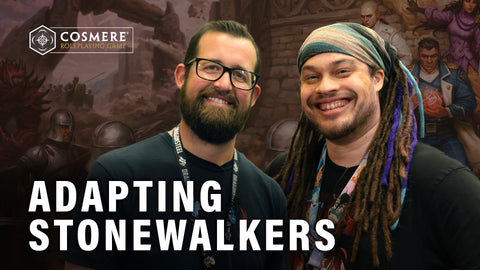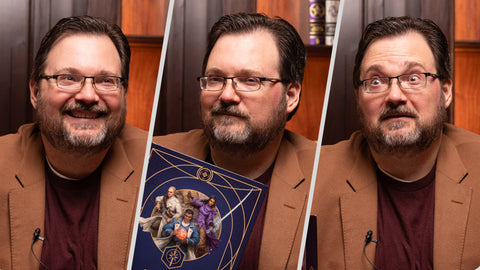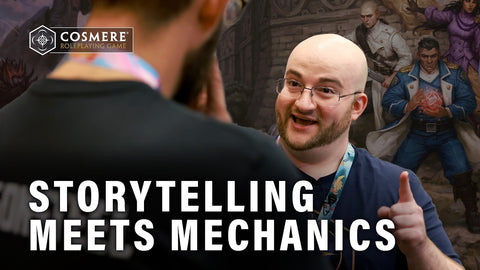The following interview includes paraphrased questions and answers to make it easy to scan through. These are not meant to be taken as direct quotes.
Q: Can you share a bit about your journey to working with Brotherwise and Brandon Sanderson?
Meric: My journey with Brandon Sanderson's work started back in middle school when my cousin introduced me to The Wheel of Time series. From there, I dove into Mistborn and became hooked. I've read and reread the books countless times. Professionally, I've worked on RPGs like Star Trek and The Expanse, but when I heard about the opportunity to work on the Stormlight RPG, I knew I had to be a part of it.
Q: What was it like working on the Stonewalkers’ adventure?
Meric: It was a dream come true. I got to take the outline that Brandon and Dan Wells created and turn it into a fully fleshed-out chapter. Specifically, I worked on Chapter 3 and the finale, Chapter 6. Chapter 3 is your classic dungeon crawl with a mix of scenes where players interact with characters, fight monsters, and even encounter a monologue statue—it's fantastic. It was challenging to balance the game mechanics as players start to pick up their Radiant powers around level 3, making previously difficult tasks easier. For example, once they gain Gravitation, they can just fly up obstacles, so we had to find ways to keep the game challenging.
Q: What was the most rewarding part of the experience for you?
Meric: Honestly, seeing players engage with the world of Roshar and experience those iconic moments firsthand was incredibly gratifying. I feel privileged to be telling stories within this universe, especially ones that are considered canon. Since Brandon wrote the outline, we now know what happened behind the scenes in the books, and it's amazing to be part of that.
Q: How do you balance gameplay for characters with and without powers in the RPG?
Meric: Balance is always a key consideration. While Investiture is powerful, it's also limited. You can only pull so much power and make so many moves in one turn. The game isn't just about combat; sometimes, you need to be a politician or use other skills. You can vary your character builds—like Kaladin, who isn't just a Windrunner but also has skills as a surgeon, warrior, and leader. To tell a good story, you need that variety.
Q: What would you say to someone who's new to The Stormlight Archive but interested in the RPG?
Meric: I’d say give it a try! The game is designed to be accessible and challenging, regardless of your experience level. If you're a Stormlight fan, you're ready to play. If you're new to the series but love TTRPGs, we've got a world guide to help you explore. The system is flexible, and you can choose your complexity level. Radiant paths, for example, are more complex, so if you're up for the challenge, dive in!
Q: Do you have any advice for GMs running the game?
Meric: Definitely! Pump up the system by using the plot die a lot. Create interesting scenarios around your table so players are encouraged to take risks and challenge themselves narratively. It’s all about making the game dynamic and fun.
Q: What makes Roshar a great environment for storytelling?
Meric: Roshar is such a rich setting with deep, meaningful character arcs. It's not just about the epic battles; it's about the internal struggles and growth of characters like Kaladin and Shallan. Stormlight has this powerful balance where characters can be heroic but also take time for personal reflection. I hope players incorporate personal obstacles as their characters grow through the story—that’s what makes Roshar perfect for a role-playing game.
Q: What can players expect from the Stonewalkers and Bridge 9 adventures?
Meric: Stonewalkers is packed with the crunchy lore that fans crave. It takes players from level one to level seven and offers a deep dive into Roshar. Bridge 9 is a level one adventure that’s ready to go right out of the box, offering narrative freedom and a whole session or two of gameplay. Both adventures provide a great mix of character types and storytelling opportunities.
Q: How are the Singers represented in the game?
Meric: It was incredibly important to us to tell the story of the Singers from their perspective. We don’t just call them Parshmen or reduce them to a single culture. We explore their identity and the struggles they face after being enslaved and then reawakened. Oathbringer really humanizes the Singers, showing that they aren’t the bad guys—Odium is. In the game, you can play as a Singer with unique ancestry options, including forms like warform, nimbleform, and odiumform. The goal is to understand their culture and experience their journey in a meaningful way.
Q: Any final thoughts for fans of the Cosmere and TTRPGs?
Meric: I’d just encourage everyone to dive in and explore the possibilities. Whether you’re playing as a Radiant or a non-powered character, there’s so much depth to uncover. And for those who haven’t yet experienced the Stormlight Archive—read the books! It’s an incredible journey, and the game is a great way to immerse yourself even further into the world of Roshar.



